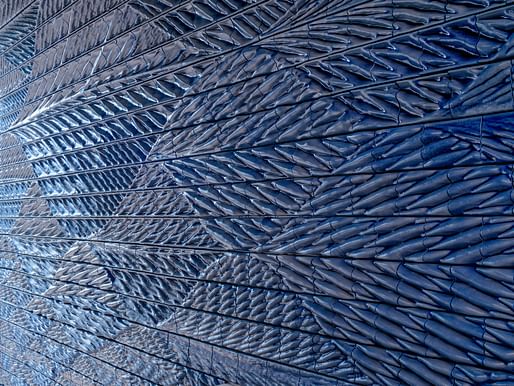
Rotterdam-based Studio RAP has completed a 3D-printed ceramic walkway in the Dutch city of Delft. Titled 'New Delft Blue,' the project “reinterprets the world-famous decorative qualities and design vocabulary of Delft Blue porcelain,” with a fusion of 3D clay printing, computational design, and artistic glazing.

The scheme is located in the communal courtyard of the PoortMeesters residential building block. Within the block, two large arching gates cover a public staircase, drawing reference from Delft’s historical role as a trading city. Studio RAP’s intervention within the arched passage takes its inspiration from traditional Delft Blue porcelain plates, whose vocabulary has changed radically over centuries with influence from Chinese and Japanese designs.

“The differentiation between a decorative, nature-inspired frame and idyllic scene, however, has been a recurring trait,” Studio RAP explains. “As such, this division is the starting point for the New Delft Blue design, where the idyllic scene is the ever-changing courtyard life while the gates stand as a three-dimensional frame with algorithmically designed nature-inspired patterns that guide people from the public space to the semi-public courtyard.”

Studio RAP’s intervention sees approximately 3000 unique 3D-printed ceramic titles cover the two gates. The patterns for the tiles were determined using an algorithmic model which factored in manufacturing constraints such as maximum overhangs, widths, heights, and depths, as well as shrinkage and internal support structure requirements. In a technique that the team calls “painting with shapes,” the tiles are coated in a “transparent blue runny glaze” that creates light and dark blue tones on the convex and concave areas of the tiles respectively.

“The deep blue color reflects the connection to Delft Blue porcelain and the surrounding canals, and it provides a pleasing contrast to the earth-toned brickwork of the building,” the studio adds. “Combining this all together the project embodies the unique identity of Delft in a contemporary way, by referring to its history with its algorithmically designed nature-inspired patterns in blue and referring to Delft of today as the city of knowledge by using cutting-edge design and 3D printing technology.”

News of the scheme comes weeks after the world’s largest 3D-printed structure made progress in Florida. Other 3D printing-related developments reported recently in our editorial include OpenAI’s new 3D model tool Shap-E, and a new 3D printing housing facility in Mexico that seeks to cut construction time by 50 percent.
No Comments
Block this user
Are you sure you want to block this user and hide all related comments throughout the site?
Archinect
This is your first comment on Archinect. Your comment will be visible once approved.